

How K-12 Students and Teachers Can Develop Clear Expectations for Learning. Ensuring that students are clear on the expectations of learning is one of the most effective ways to impact student achievement.
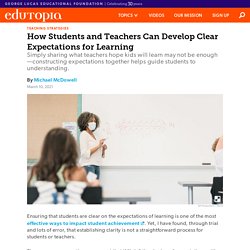
Yet, I have found, through trial and lots of error, that establishing clarity is not a straightforward process for students or teachers. There was an assumption on my part that if “I do” the sharing of expectations with kids, they will learn. I thought if I shared the learning expectations verbally, stated the goals clearly on the board, provided easy-to-read rubrics, and gave students time to write down the learning expectations, they would develop clarity. That didn’t seem to do the trick for most kids. Akin to hearing a lecture without checks for understanding, students watched me teach but didn’t take an active approach to ensuring that they understood the expectations of learning. 3 Popular Co-construction Strategies 1. Here are a few examples: 2. What was the error? 3. Twitter. How to Cultivate Confidence in Students (Opinion)
This is the second in a four-part series on self-efficacy.

Read the first piece on why students persist or quit here. After students fail a test, how do I help them believe in themselves again? 3 Strategies for Promoting Deep Learning Virtually. The Mistake Imperative—Why We Must Get Over Our Fear of Student Error. For Disney, creativity and mistakes went hand in hand.
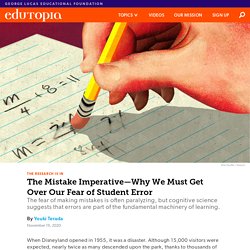
As the founder of a company that offered fantasy as its core product, he encouraged his team of engineers, designers, and mechanics—you may know them as Imagineers—to think expansively and be willing to break things. “I don’t remember anyone getting fired for coming up with a dumb idea or making a mistake,” recalls Van Arsdale France, one of Disney’s earliest employees. Yet all too often, students see mistakes as a source of embarrassment, stress, or even humiliation.
The human brain is agnostic, however, and makes good use of the data—mistakes are crucial pieces of information that force a cognitive reckoning, pushing the brain to reconcile contradictory information and build more accurate, durable solutions. Recent magnetic resonance imaging (MRI) studies reveal the underlying neural machinery at work.
Acknowledge That the Fear Is Real The fear of failure is deep-seated. Work in the Zone of Proximal Development. Encouraging Student Self-Reflection. As part of my school’s PBIS behavior management system, students have the opportunity to earn “tokens” they can save and redeem for rewards.

A student favorite is the Stinky Feet pass, which allows students to work in the classroom with their shoes off for the day. Teachers can give students a Rocket Buck when they observe behavior that is consistent with the school expectations. As an intervention teacher, I like to be able to reward my students, but I also want the reward to be meaningful. In other words, they have to earn it! TeachThought sur Twitter : "“Are there questions students can ask themselves while you’re teaching? Questions that can guide and support their own thinking and awareness before, during, and after your teaching?” A1: Research from outside of math talks about how movement improves attention and more while reducing stress.... #ElemMathChat #mathMovement… Mark Chubb sur Twitter : "A4 If we want learning to be “sticky” we could: -Focus on connections between concepts (not rules/procedures) -Delve deeply into a few powerful visual tools that help us make connections between concepts -Focus on reasoning not m.
How Revising Math Exams Turns Students Into Learners, Not Processors. Teaching metacognitive skills According to Cover, the Lakeview School District has had “a big equity push” in recent years, with two organizations being brought in to lead monthly dialogues for cohorts of about 15 faculty members.
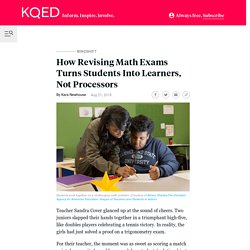
Those dialogues prompted Cover to reflect on areas where she had struggled in school — primarily writing. The Power of Productive Struggle. There is an increasing trend of parents clearing the path for children and removing any barriers within their control that could make things more difficult for their children i.e the college admissions scandal, which is also known as lawnmower parenting.

This is typically done with the best intent and although I don’t love labeling people like this, some of these practices have real implications for how children develop that we should be aware of. Although many educators are quick to lament this type of parenting as it interferes with their teaching, we aren’t totally removed from it as educators (especially since most of us educators are also parents.).
As a parent myself, I acknowledge that it’s hard to know the right balance as I, along with many parents, want our children/ students to be successful and so of course, if we can remove barriers it feels like it is the right thing to do… but is it??? This is true in education as well. Peter Carpenter, Ed.D. sur Twitter : "The @HCPSchools @_CCEScougars thoughtfully overlaying several models of engagement to elevate their own understanding of how to slide students from compliance to engagement in their instructional planning. Check out s.
Limiting “Teacher Talk,” Increasing Student Work! “Wah waah wah waah wah wah…” We all know the famous muted trumpet of adults in Charlie Brown’s world, especially their teacher, Miss Othmar.
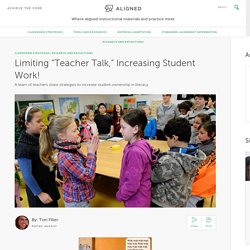
"Emotion and learning are completely connected." Research shows that students who feel safe and supported by adults at school are better able to learn. #HowLearningHappens… Student perceptions vs reality with active learning. Fascinating new study from Harvard - Have you seen this @joshua_r_eyler ? Learning to Listen and Listening to Learn — zacharychampagne.com. And with these two inputs, I became fascinated with the power of not talking so much.
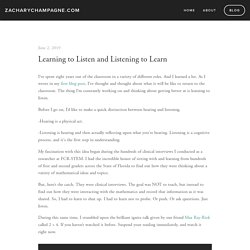
Defining Moments That Changing Teaching Practices. We know the world is changing.
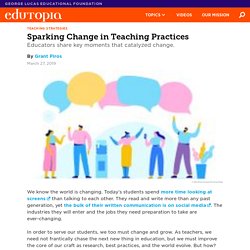
Today’s students spend more time looking at screens than talking to each other. They read and write more than any past generation, yet the bulk of their written communication is on social media. The industries they will enter and the jobs they need preparation to take are ever-changing. In order to serve our students, we too must change and grow. BCM - Manipulatives and Multiple Representations. Never Skip the Closing of the Lesson. Once again, Tracy Zager has pushed us to think about our teaching. In her recent talk at #TMC16 Tracy asked us to consider what it means to “close the lesson”. Here is an example of a problem and a potential close, followed by some of my thoughts about how we should close any lesson. First of all, give a problem that will help you achieve a specific goal. Take this problem published in Marilyn Burn’s 50 Problem Solving Lessons resource: If rounds 1 & 2 of a tug-of-war contest are a draw, who will win the final round?
Here is the full problem. Once students understand the problem and are given time to write their solution (individually or in pairs) the learning isn’t over. Closing the lesson: Robertkaplinsky. Turning Math Into a Game. Let’s play a game.
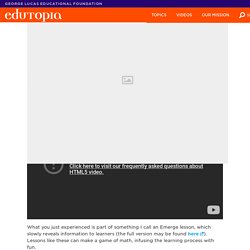
Ready? I’ll show you an object and you try to guess its mass. We’ll play three rounds. To start, play the video below, pausing when instructed. There has been an error with the video. Robertkaplinsky. De-emphasizing Speed in Math. I recently spoke to the mother of a 1st grade student who told her mom that she was bad at math because everyone in the class could answer so much more quickly than her.
Heartbreaking. Six years old and already feeling that she is a failure at math. It got me thinking about what instructional shifts are needed in our math classrooms to de-emphasize speed in math and place more of an emphasis on reasoning and understanding. This post contains affiliate links, which simply means that when you use my link and purchase a product, I receive a small commission. There is no additional cost to you, and I only link to books and products that I personally recommend.
Emphasize the process over the product. Public Media for Northern CA. Oakley recognizes that “many educators are not at all comfortable with or trained in neuroscience,” so she breaks down a few key principles that teachers can use in the classroom and share with students to help them demystify the learning process. 1. The Hiker Brain vs. The Race Car Brain Start by teaching students the difference between focused and diffused thinking, says Oakley.
When the brain is in focused mode, you can get started on the task at hand. #TeamBlankSpace – Embrace the Challenge. Math Language Routine Article.pdf. Seeing Struggling Math Learners as 'Sense Makers,' Not 'Mistake Makers' New post: How Do You Make Math Fun? Why students need more 'math talk' Test scores, school report cards and Facebook posts complaining about homework problems often drive critiques of how math is taught in schools. Amid the debates, it has become increasingly clear that one ingredient is necessary for success: opportunities for students to talk about math.
Unfortunately, these are often lacking in U.S. classrooms. A Grading Strategy That Puts the Focus on Learning From Mistakes. "I see that now when I give tests back, they're continuing to learn," Alcala said. The students get their grade a day later on PowerSchool, and they're given opportunities to retake the test after they've digested their mistakes. Focus on Relational Understanding. Forty years ago, Richard Skemp wrote one of the most important articles, in my opinion, about mathematics, and the teaching and learning of mathematics called Relational Understanding and Instrumental Understanding. If you haven’t already read the article, I think you need to add this to your summer reading (It’s linked above).
Skemp quite nicely illustrates the fact that many of us have completely different, even contradictory definitions, of the term “understanding”. Phil Daro - Against "Answer-Getting" Math I Session 5 Never Say Anything a Kid Can Say Article. The role of “practice” in mathematics class. A few weeks ago a NYTimes published an article titled, Make Your Daughter Practice Math. She’ll Thank You Later, an opinion piece that, basically, asserts that girls would benefit from “extra required practice”. I took a few minutes to look through the comments (which there are over 600) and noticed a polarizing set of personal comments related to what has worked or hasn’t worked for each person, or their own children. When Kids Have Structure for Thinking, Better Learning Emerges. Why Students Forget—and What You Can Do About It. Math Journals. Making Math Moments Matter With The Concreteness Fading Model. Importance of Context and Concrete Manipulatives From Kindergarten Through Grade 12.
Two Common Misconceptions About Learning. It's another semester with a new group of students. Direct Instruction...Do We Need It? The role of “practice” in mathematics class. Addressing unfinished learning in the context of grade-level work. As a teacher, I had an understanding of the grade-level math content I was supposed to teach and the belief that students’ new learning had to build from their prior understanding. Edutopia. Math used to be all rote memorization and pencil-to-paper equations disconnected from the real world, but more and more teachers are realizing the importance of making practical, relevant connections in math. How Questions Help Students Learn. Math Game Short List 2018. Edutopia.
Why CRA? Why Students Forget—and What You Can Do About It. San Francisco school finds key to raising math scores: Teacher training. Workstations, Not Worksheets! Limiting “Teacher Talk,” Increasing Student Work! Limiting “Teacher Talk,” Increasing Student Work! Making Math Visual. NCTM 2018 Presentation Resources 'Engaging Students in Seeing Structure'. - Sara VanDerWerf. 30 Habits Of Highly Effective Teachers. 'Too Often, Teachers Deny Their Own Expertise': John Hattie on the Educator Mindframe - Teaching Now. Tips For Grading Math Test: Highlighting Mistakes. AllThingsPLC Magazine by Solution Tree. Smart Strategies for Student Success. 31 Surprising Facts About Learning. The Importance of Debriefing in Learning and What That Might Look Like in the Classroom. Education Week. Ww2.kqed. Building a Thinking Classroom in Math.
5 Beliefs that Prevent Teachers From Increasing Math Rigor. Math Doesn’t Have to Suck. Here Are Three Ways to Make It Better. Natural Resources. Rife With Conflict. Mathematics, Everywhere for Everyone. Ww2.kqed. 14 Resources on Crafting Learning Objectives. 22 Powerful Closure Activities. Food for Thought - Robert Kaplinsky. Ww2.kqed.
Five Classroom Dimensions That Show Deep Math Learning Is Happening. Quick fixes and silver bullets… – Thinking Mathematically. KQED Public Media for Northern CA. How Students Critiquing One Another’s Work Raises The Quality Bar. Suzanne at the Math Forum. Balancing the Equation. Videos and Docs - Teach at the Speed of Learning. Paying Attention to OUR Understanding! – Thinking Mathematically. How Relearning Old Concepts Alongside New Ones Makes It All Stick. 20 Questions That Schools Should Be Asking About Professional Development. Golden Rules for Engaging Students in Learning Activities. Goodbye, Linear Factory Model of Schooling: Why Learning is Irregular. Deeper learning.